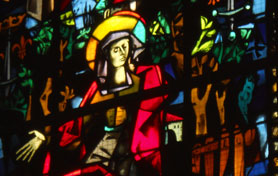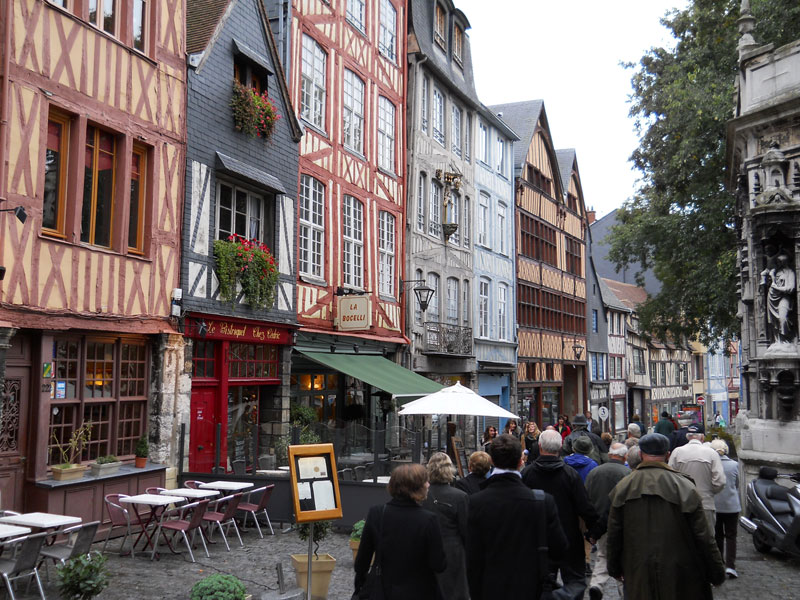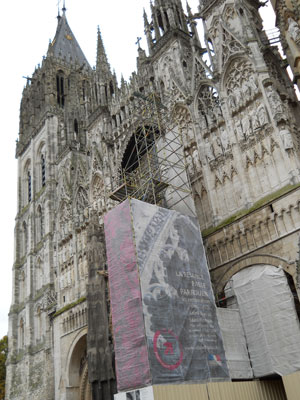
Rouen cathedral, under renovation, is where William the Conquerer and Richard the Lion Hearted have their tombs. According to our walking tour guide, Richards heart is buried there.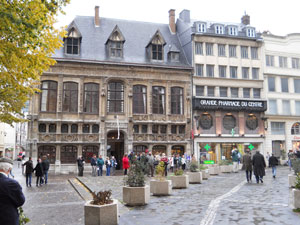 The building on the left, second floor, is where Monet rented a room and from where he painted the cathedral. Below is the clock arch, gateway to the old town square where Joan of Arc was burnt at the stake. The building on the left, second floor, is where Monet rented a room and from where he painted the cathedral. Below is the clock arch, gateway to the old town square where Joan of Arc was burnt at the stake.
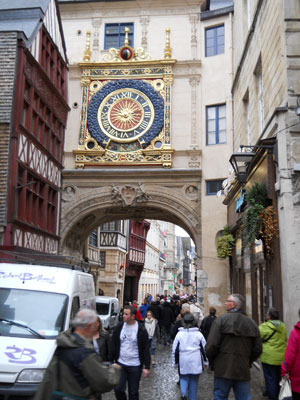 |
Rouen
Wednesday, November 3, 2010
First stop on our walking tour of Rouen is in front of the cathedral that Monet painted many times. Our guide, Gabrielle, pointed out that Monet rented an apartment in the building right in front of the cathedral. From his window he could see the front of the cathedral and he painted it in morning and afternoon light, on a grey day, etc.
Now Gabrielle is an artist and very charming, but her accent sometimes gets the better of her and she admits right at the start of our walk that she is still learning the language. She points out the "big cock" on top of the spire of the cathedral, a symbol of Normandy and France. This is her English joke explaining the reaction she got when she first used this phrase. She is not about to switch to rooster and lose the chuckles.
A big part of our 2 hour tour in Rouen is centered on the cathedral. We go inside to see the windows and the tombs of William the Conquerer and Richard the Lion Hearted both kings of Normandy and England. Gabrielle keeps talking about Richards "har" and it took us a while to realize she meant "heart" and she was using the French pronounciation of the word, the "t" being silent. Apparently, Richards heart is in the tomb, the only part of him that was brought back to Rouen to be buried. William's body was brought back during the summer and kept blowing up and being sewn shut... a horrific and smelly journey to be sure.
Our tour continued taking us to a building with an internal garden which was a burial site for victims of the plague. The buildings that surrounded the grounds were carved with skulls.
We walked through the streets, past shops, a restored court building that was almost completely demolished during the war and under an archway with an elaborate clock. We reached the town square where there is a chapel with an exterior inspired by Viking ships. It is dedicated to Joan of Arc and outside the chapel is the spot where it is said she was burned at the stake. 
The sign reads, "The location where joan of Arc was burnt on May 30th, 1431. The roof of the chapel is in the background. |
After another commentary about Joan of Arc from our guide, with another guide adjacent doing the same we emerged from the chapel and had free time in Rouen. We shopped, bought some macaroons, and then returned to the boat for cocktails, dinner.
Normandy
| 

